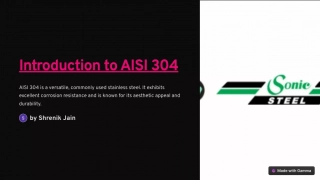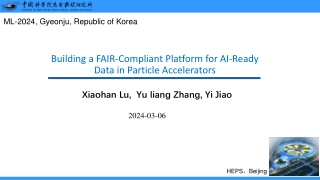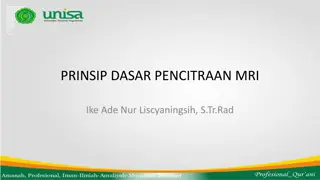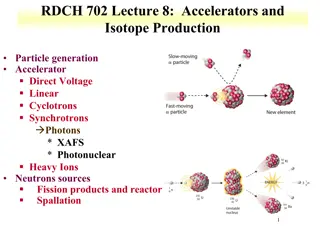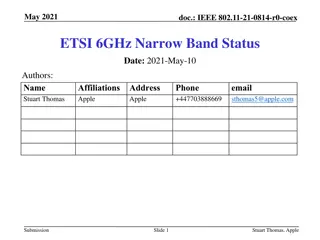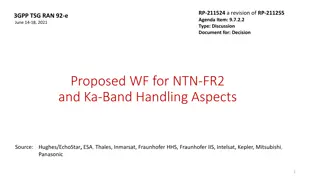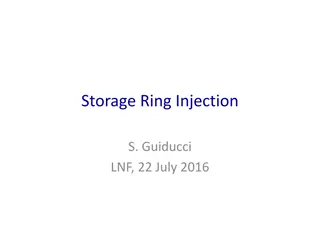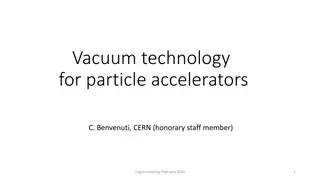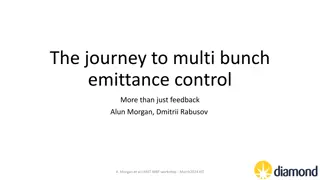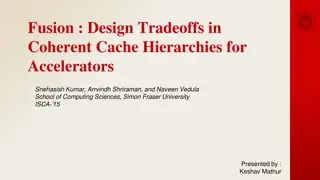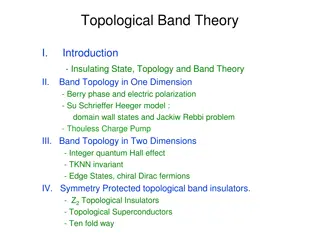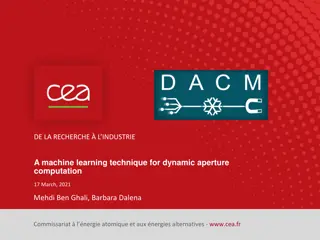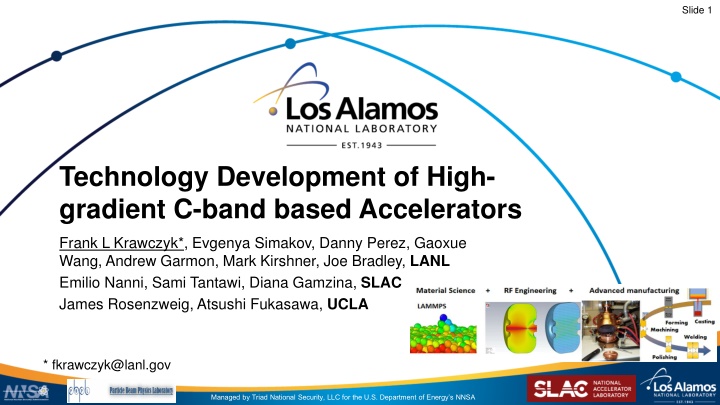
Technology Development of High-Gradient C-band Accelerators
Explore the advancements in high-gradient C-band accelerator technology, including molecular dynamics tools, RF breakdown studies, and future plans for achieving gradients at or above 100 MV/m. Discover the importance of C-band frequency for LANL applications and the development of RF-source technology for higher peak power capabilities.
Uploaded on | 0 Views
Download Presentation

Please find below an Image/Link to download the presentation.
The content on the website is provided AS IS for your information and personal use only. It may not be sold, licensed, or shared on other websites without obtaining consent from the author. If you encounter any issues during the download, it is possible that the publisher has removed the file from their server.
You are allowed to download the files provided on this website for personal or commercial use, subject to the condition that they are used lawfully. All files are the property of their respective owners.
The content on the website is provided AS IS for your information and personal use only. It may not be sold, licensed, or shared on other websites without obtaining consent from the author.
E N D
Presentation Transcript
Slide 1 Technology Development of High- gradient C-band based Accelerators Frank L Krawczyk*, Evgenya Simakov, Danny Perez, Gaoxue Wang, Andrew Garmon, Mark Kirshner, Joe Bradley, LANL Emilio Nanni, Sami Tantawi, Diana Gamzina, SLAC James Rosenzweig, Atsushi Fukasawa, UCLA * fkrawczyk@lanl.gov Managed by Triad National Security, LLC for the U.S. Department of Energy s NNSA
Slide 2 Outline Work completed since the last meeting Fully funded 3-year program (until Sept. 2022) Established molecular dynamics tools for RF-breakdown studies Established relevance of C-band as best frequency for LANL applications Acquisition and installation of C-band klystron and test-stand Present and future plans Develop better understanding of RF-breakdown (see talk by Danny Perez) Develop C-band structures for gradients at or above 100 MV/m ( =1.0) Better materials and fabrication techniques Cryo-cooled operation at 77K Develop C-band structures for proton applications (e.g. pRad) Energy and ( ) range: 140 MeV to 20 GeV (0.5 to 1.0) Moderate gradient up to 40 MV/m Develop RF-source technology to higher peak power, flexible RF-pulse format Managed by Triad National Security, LLC for the U.S. Department of Energy s NNSA
Slide 3 Molecular Dynamics Simulation Tools Most accurate Density Function Theory (DFT), quantum physical approach Slow, only small ensembles of particles, not good for dynamic effects Manageable Classical Molecular Dynamics (MD) with modifications Faster, more relevant ensemble sizes, multiple grains, dynamics up to a few s What is missing Electromagnetic (EM) Forces are insufficient to create breakdown precursors EM model does not obviously lead to low breakdown limits Effects that have to be included Thermal Fatigue Plasma forming at nano-tips (e.g. Flyura Djurabekova, Univ. of Helsinki) Propagation of defects to the surface (e.g. Yinon Ashkenazy, Hebrew Univ. of Jerusalem) Managed by Triad National Security, LLC for the U.S. Department of Energy s NNSA
Slide 4 C-band Relevance for LANL Applications a/ = 0.24 Shunt Impedance Longitudinal Wakes Energy Change Transverse Wakes Deflection at 1 m Units M /m V/pC @ 1 GeV V/pC/m kV S-band 47 11.7 1.1% 12.2 0.12 C-band 66 16.1 1.5% 67.1 0.64 X-band 94 22.1 3.4% 366.3 3.50 RF performance metrics for RF structures (efficiency, gradient and multi-bunch decoupling) favor higher frequency (C and X). Coupling between an RF structure and the transported beams (good and bad wake fields) favor lower frequency (S and C). Ease of fabrication and RF-transport losses also favor the lower range (S and C). C-band (5.712 GHz) is the only established frequency that has favorable properties on all these criteria. a/ = 0.10 Shunt Impedance Longitudinal Wakes Energy Change Transverse Wakes Deflection at 1 m Units M /m V/pC @ 1 GeV V/pC/m kV S-band 85 26.5 2.5% 155 1.5 C-band 120 36.4 3.5% 835 8.0 X-band 170 50.4 7.7% 4420 67.4 a/ = 0.04 Shunt Impedance Longitudinal Wakes Energy Change Transverse Wakes Deflection at 1 m Units M /m V/pC @ 1 GeV V/pC/m kV S-band 86 45.8 4.4% 306 2.93 C-band 121 64.3 6.1% 1683 16.1 X-band 172 90.5 13.8% 9037 86.4 Managed by Triad National Security, LLC for the U.S. Department of Energy s NNSA
Slide 5 C-band Engineering Research Facility (CERF-NM) Development of C-band technology is a high LANL priority DDSTE and the ALD for Physical Sciences invested $1.3M into purchase/installation of a 50 MW peak power klystron Klystron supports our 3-year effort for sample and cavity testing Complimentary efforts, mostly in collaboration with UCLA and SLAC (e.g. on injector, diagnostics, RF- sources, C-band RF-components) to develop facility into electron beam test accelerator Collaborative proposals on compact FELs, cryogenically cooled RF-structures, reduced - structures for medical, isotope production or pRad Managed by Triad National Security, LLC for the U.S. Department of Energy s NNSA
Slide 6 High-Gradient Structures for Electron Beams Material Science effort better understanding of RF-breakdown Are there better copper alloys with lower RF-breakdown probability? RF-structures Design and test reference structures from regular copper (SW, waveguide manifold coupling) Test cavity for sample testing we try to do more than DC testing Develop new Rf-structures based on cryo-cooling copper (77K) Advanced manufacturing Implement low-temperature machining, forming, joining and cleaning techniques Fabrication infrastructure: methods that do not compromise the properties of source materials In-house fabrication of newly developed RF-resonators Managed by Triad National Security, LLC for the U.S. Department of Energy s NNSA
Slide 7 High Gradient Structures for Proton Beams Leverage Material Science and Advanced Manufacturing work Structure and beam dynamics simulations to determine suitable start energy for C-band structures decide velocity grading scheme Final pRad concept might have a S-band front end Test reduced -structures in collaboration with SLAC Design, build and test multi-cell resonators Optional beam tests at LANSCE Develop technology use cases for technology pRad Isotope production Medical accelerators Managed by Triad National Security, LLC for the U.S. Department of Energy s NNSA
Slide 8 Concepts for new C-band Source Technology Standard C-band klystron configurations are limited We need higher power, flexible pulse formats and longer pulses Path to MBKs has challenges (e.g. over-moding) Plan to develop proposal on collaborative effort with SLAC Better modulator/HV technology High current density cathodes (Nanocomposite Scandate Tungsten (NST) cathodes) Multi-beam klystron development Managed by Triad National Security, LLC for the U.S. Department of Energy s NNSA
Slide 9 3-year Effort Managed by Triad National Security, LLC for the U.S. Department of Energy s NNSA
Slide 10 Acknowledgements LANL DDSTE, ALDPS (infrastructure investment) LANL Accelerator, Theory and Fabrication divisions (multidisciplinary approach) LANL LDRD program RF source group at SLAC PSI SwissFEL Managed by Triad National Security, LLC for the U.S. Department of Energy s NNSA

